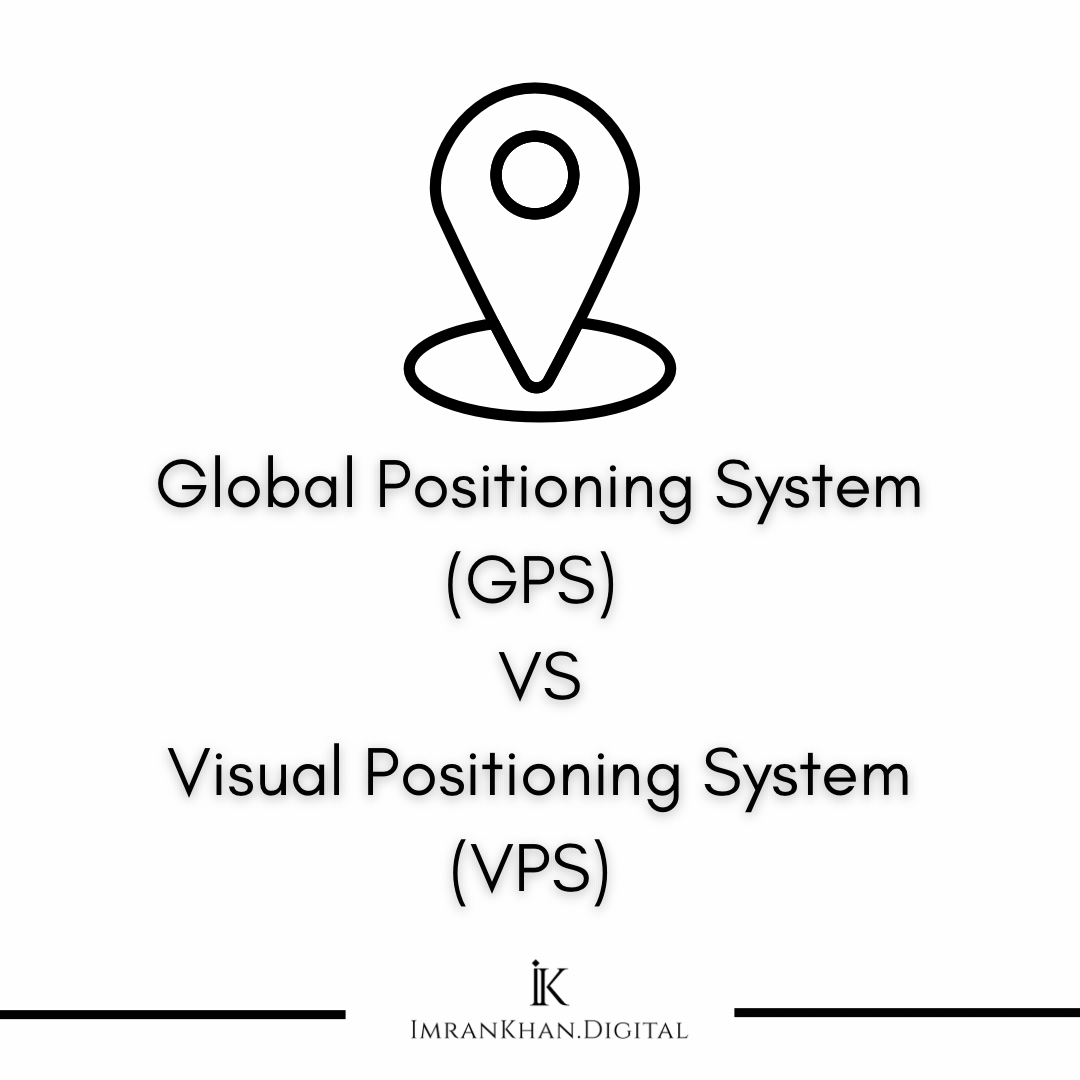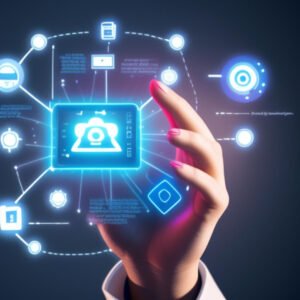
What is GPS and VPS?
Global Positioning System (GPS) and Visual Positioning System (VPS) are both used to navigate people and places. GPS uses a network of satellites orbiting the Earth to provide users with a precise location, whereas VPS relies on camera data, AI and deep learning technology to determine a person’s position within an environment.
GPS works best in open areas with a clear view of the sky, and VPS is better for navigation indoors, when access to satellites is limited. VPS also has the potential to deliver a more precise, contextual experience since it relies on specific environmental cues to create a map.
For instance, VPS can understand how many steps there are to a staircase or even provide details about which floor an elevator is on. In summary, GPS and VPS are both incredibly useful for navigation, but for different environments and applications.
Let’s discuss GPS in detail.
What is the Global Positioning System (GPS) and how does it work?
The Global Positioning System (GPS) is a network of orbiting satellites operated by the United States Department of Defense that can determine the exact location of a person on Earth, using a set of three-dimensional coordinates. It is made up of 24 operational satellites which circle the globe in 12 hours, sending precise positioning signals.
In order to use GPS, the device receiving the positioning signals, such as a GPS receiver, must be able to read them and translate them into useful data. It does this by receiving a signal from at least four satellites at the same time. Each satellite will send a unique set of information, which the device uses to measure its relative distance to each satellite, the Doppler Effect, and timing of the signal. From there, the receiver is able to triangulate its position and determine the exact coordinates of the device’s current location.
GPS has been used in various industries such as agriculture, aviation, defense, transportation, and navigation. It is even used by individuals in order to stay safe in remote areas and navigate unknown terrain.
Overall, the Global Positioning System is an amazing tool for navigation and continues to be relied on for its precise and reliable positioning signals.
Who invented GPS?
The invention of the Global Positioning System (GPS) is attributed to a group of U.S. military engineers, Roger L. Easton, Ivan A. Getting, and Bradford Parkinson. The trio first developed the navigation system during the Cold War to provide navigation and location services to the U.S. military and it was fully operational by 1995. Since then, GPS has become a standard technology for consumer navigation, finding its way into all types of applications from automobile navigation systems to fleet management to fitness tracking.
What are the components of GPS?
What is GPS?
GPS, which stands for Global Positioning System, is a network of satellites used to pinpoint the exact location of any person or object on the surface of the Earth. It can be used for a variety of purposes such as tracking and navigation, especially for transportation.
Components of GPS
1. GPS Satellites
GPS relies on a constellation of around 24 satellites that circle the Earth. These satellites are what allows users to determine their location on the Earth’s surface. The satellites send out signals, which the GPS receiver picks up.
2. GPS Receiver
The receiver is what a user interacts with when trying to obtain their coordinates or location. This is usually in the form of a phone or other handheld device, though it can also be built into vehicles. The GPS receiver uses the signals from the satellites to triangulate a location and send it back to the user.
3. Data Hub
Data Hubs are the computers that manage the data between the satellites and receivers. It ensures the receivers get the signals from the satellites accurately, which then determines a user’s exact location. The data hub is responsible for storing the data from the satellites and then providing the necessary updates to the GPS receivers.
4. Geographical Information System (GIS)
GIS is an information system that uses computers to store and analyze spatial data. It provides detailed maps that allow users to locate objects in relation to the surface of the Earth. GIS allows the GPS receiver to determine an exact location and the most efficient route between two points.
5. Base Station
Base stations are located at the exact spot that needs to be tracked. These base stations provide GPS receivers with a base signal so they can determine the location more accurately. This can be used to monitor fleets of vehicles and other mobile objects.
GPS Technology – GPS Receiver, Chips & Modules
GPS Technology
GPS Receivers
GPS receivers are small, highly-precise devices that use a network of 24 Earth-orbiting satellites to locate and accurately measure its own location, speed, and altitude. It receives the satellite’s radio signals, measures their travel time and accurately pinpoints the user’s position, typically with an accuracy of between 2-10 meters. It is a versatile device with a wide range of applications in outdoor navigation, sports, asset tracking, and automotive guidance.
Chips
GPS chips are miniaturized components which allow devices to acquire location and time data from satellites. The chips also contain several necessary components for reception, amplification, demodulation and filtering, making them vital for a functioning GPS device. Some examples of their applications are in navigational devices, smartphones, vehicle positioning, smartwatches and augmented reality (AR) devices.
Modules
GPS modules provide both integrated solutions for existing electronic systems as well as a powerful starting point for new projects. By incorporating a GPS module into existing electronics, one can build powerful applications with enhanced positioning capabilities. For example, they are widely used in automotive systems, security systems, and robot guidance. They provide features such as real-time tracking, routing, 3D navigation and electronic maps.
What are the types of GPS?
Types of GPS
1. Standalone GPS – These are self-contained devices that contain both the hardware and software for location-tracking. The data from these devices is accessible either by plugging into a computer, or wirelessly via a built-in wireless data connection.
2. Cellular/Cellphone GPS – Cellphone GPS units use cellular data to connect to the GPS satellites, so they don’t need to be attached to a laptop or other computer. They can be used on the go and give accurate location data to a mobile device.
3. Smartphone GPS – Smartphones are now capable of giving their users access to the full range of GPS data, including street maps, route planning, and geocoding. Many of the latest smartphones include advanced navigation systems with the ability to follow roads and other objects in real-time.
4. Geofencing GPS – Geofencing is the use of GPS technology to define and track geographical boundaries. Geofencing uses an area’s coordinates and virtual barriers to set up an invisible fence, allowing an organization or business to monitor an individual’s location within the virtual boundaries.
5. Fleet GPS Tracking – Fleet GPS Tracking uses GPS technology to track the movements of vehicles within a fleet, allowing the fleet manager to stay up-to-date on vehicle location and driving habits. Fleet GPS Tracking systems can also provide speed limits, alerts for when drivers exceed these limits, and provide other helpful features for fleet managers.
What are the uses of GPS?
Uses of GPS
1. Navigation:
GPS technology allows for enhanced navigation accuracy, even when people are traveling in remote areas or have limited visibility due to weather conditions. With the help of GPS devices, travelers can easily locate themselves, get directions, or locate points of interest.
2. Precision Agriculture:
GPS technology is becoming increasingly useful in precision agriculture. This form of agriculture uses sophisticated equipment and sensors that are connected to GPS technology to manage crops and soil, maximize yields, reduce costs, and limit environmental impact.
3. Fleet Management:
GPS tracking systems are becoming an essential tool for companies with fleets of vehicles or goods in transit. Companies are using these tracking systems to improve their efficiency, monitor drivers, optimize routes, and keep tabs on vehicle and goods whereabouts.
4. Geotagging:
GPS technology is often used to automatically attach geographical data to photographs. This process is known as geotagging and is popular with tourists and adventurers who wish to share their photos online and keep a record of the locations in which they have been.
5. Military Operations:
GPS systems are essential for modern militaries to plan and execute effective strategies and operations. With GPS, military personnel can navigate accurately, pinpoint locations and positions of enemy forces, and even coordinate weapons strikes.
How to install GPS? Step by step guide
Step 1: Buy a GPS unit
Choose a GPS unit that suits your needs and budget. Be sure to check its compatibility with your device, such as your mobile phone or laptop.
Step 2: Locate the Antenna
Connect the antenna to the back of the GPS unit.
Step 3: Set Up Your Device
Install any necessary software that came with the unit. Then, attach the unit to your device. This will allow your device to receive the GPS signals from the antenna.
Step 4: Set the Time Zone
Adjust the time zone settings so that the unit matches the location you’re in.
Step 5: Test the GPS
Turn the unit on and check that the signals are being received properly. Try a test route, and make sure the route is being tracked properly.
Step 6: Enjoy!
Once the GPS is properly installed, you’re ready to hit the road and start exploring! Have fun!
What is the frequency of GPS?
The frequency of the Global Positioning System (GPS) is 1575.42 MHz, with a frequency tolerance of + or – 25MHz. GPS works by triangulating the location of a GPS-enabled device based on the reception of signals from three or more GPS satellites that transmit signals at the same frequency.
What is the accuracy of GPS?
The accuracy of GPS is typically between 3 and 10 meters. However, with new technology, the accuracy can range from 1 to 5 meters. Different factors, such as satellite positioning, receiver clock frequency, and atmospheric conditions, can also impact the accuracy.
By using technologies like Differential GPS and Advanced Receiver Autonomous Integrity Monitoring, the accuracy of GPS has increased even more, leading to better navigational services for people and businesses around the world.
What are the examples of GPS?
Personal Navigation:
One of the most well-known uses of GPS technology is for personal navigation. It allows users to use satellite navigation and track their route in real-time, enabling them to get to their destination faster and easier. This has become an incredibly popular tool for travelers and commuters, with apps like Google Maps providing real-time directions.
Emergency Services:
GPS is used in a variety of ways by emergency services, such as police and fire departments. It enables these services to locate people and vehicles in the field quickly and accurately, which is especially important during search and rescue missions or responding to emergency situations.
Asset Tracking:
GPS tracking technology can be used to track valuable assets such as vehicles and other equipment. This technology can help businesses reduce losses by making sure their assets are safe and secure at all times.
Delivery Tracking:
GPS technology is also used to track shipments, enabling businesses to know the exact location of their deliveries in real-time. This helps ensure that deliveries arrive on time and are not lost in transit.
Mobile Applications
Many smartphones now have built-in GPS, allowing users to track their location as well as use it for directions. Popular mobile applications like Uber and Google Maps rely on GPS to offer accurate directions and estimated time of arrivals for users.
Military Applications
GPS has various applications in the military. This includes air-traffic control and weapons guidance, allowing them to track a target with precision. Moreover, GPS is also used for positioning communication satellites in space as well as positioning of tanks, ships and vehicles on ground.
Logistics
Logistics companies are also using GPS to track shipments. By using a GPS tracking system, a company can monitor its delivery process from start to finish. By having access to detailed data such as the exact location of a shipment, its arrival time, and its delivery route, companies are able to maximize efficiency and better plan their delivery routes.
Geocaching
Geocaching is an outdoor activity that utilizes the GPS technology to hide containers of treasure at specific locations around the world. Individuals and teams of people search for the hidden containers using a GPS receiver to get coordinates and ultimately find the hidden containers.
Which industries are using GPS?
Industries Using GPS
• Automotive
• Shipping and Logistics
• Public Safety
• Agriculture
• Transportation
• Aviation
• Natural Resources
• Military
• Location-based Services
• Telecom
• Maritime
What is satellite navigation?
Satellite navigation is a system of satellites used to determine the exact location of a vehicle or person on Earth. It relies on data received from the Global Positioning System (GPS) and is used by smartphones, GPS navigation devices, ships, aircraft, and many other forms of transport.
By triangulating signals from a number of satellites in geosynchronous orbits, a receiver on Earth can pinpoint its exact position on the surface of the planet. Satellite navigation provides real-time positioning, helping users make decisions quickly, easily, and accurately. It is invaluable for everything from long-distance travel to planning hiking routes.
How many GPS satellites are there?
According to NASA, there are a total of 31 active GPS satellites in space at any given moment, with another 6 to 12 backups in case one malfunctions. The constellation of satellites continuously orbits around the Earth, providing reliable and accurate positioning information.
Control Segment of GPS
This GPS control segment enables the tracking of satellites, stores and retrieves the current coordinates, provides the necessary corrections, and calculates the accuracy of navigation solutions. It is comprised of monitoring stations distributed around the globe that continuously track and analyze satellite signals, send the necessary updates, and help provide navigational solutions with the highest level of accuracy.
The control segment works together with the user segment, space segment, and ground segment to accurately and securely transmit navigation signals. It is responsible for delivering navigation information with accuracy and integrity to all user locations worldwide.
Let’s discuss VPS in detail.
What is a Visual Positioning System (VPS)?
A Visual Positioning System (VPS) is a type of navigation technology that uses camera and Artificial Intelligence (AI) to allow users to accurately navigate a space indoors or outdoors. It combines computer vision, odometry, and advanced algorithms to determine a user’s location, movement and direction in real-time.
It has many potential uses in sectors such as automotive, manufacturing, and healthcare. VPS can help with navigation and guidance within large areas, to safely transport goods, or to locate certain products. VPS can be used in drones, robots and autonomous vehicles as it can make navigation much faster and more accurate than other navigation technologies.
It has been found to be most useful in complex environments, such as indoor spaces or cluttered outdoor environments where GPS signal is unreliable.
Who created VPS?
The Visual Positioning System (VPS) was created by Google Maps and its parent company Alphabet, with help from tech company Aryzon. VPS combines technologies like machine learning and computer vision to make location identification much easier than ever before. By accurately pinpointing the user’s location with augmented reality and 3D mapping, VPS allows for an incredibly intuitive and reliable user experience.
How is VPS different from GPS?
The Visual Positioning System (VPS) is a relatively new type of technology that is gaining traction in the tech world. Unlike traditional GPS, VPS utilizes computer vision, 3D imaging and machine learning to accurately measure a person’s physical location and navigate them from point A to point B.
Unlike GPS which uses a satellite signal to track and calculate positioning, VPS uses cameras, infrared lighting and special computer vision algorithms to compare physical objects around it and estimate a person’s location with respect to them. VPS also includes a wider variety of features than traditional GPS such as environment recognition, object recognition and indoor mapping.
Unlike GPS which is used mainly for navigation and travel tracking, VPS is intended to be used in indoor navigation and can even provide more detailed visual and sensory guidance. While GPS offers global navigation coverage, VPS offers more specific navigation within a set space, making it an invaluable tool for businesses, museums and other indoor settings.
How to use a visual positioning system?
The Visual Positioning System (VPS) is a technology that uses camera imagery to accurately position an object in 3D space. To use a VPS, follow these simple steps:
1. Ensure your environment has enough natural or artificial light and is free of obstructions to get an accurate view.
2. Set up the VPS by setting up the cameras in the room according to the instructions. Make sure the camera images cover the area you need to map.
3. Plug in the VPS into a power source and connect it to the camera network.
4. Activate the system and wait for the initialization to be completed.
5. Use a tracking marker, like an LED light or sticker, to calibrate the system.
6. When calibration is complete, you are ready to use the system. Place the tracking marker on the object or person that you wish to track and the system will start tracking them.
7. You can visualize the positioning data and monitor the progress of your subject in real-time.
Enjoy your experience with the Visual Positioning System!
Google Visual Positioning System API
With Google’s Visual Positioning System (VPS) API, I can create augmented reality (AR) applications with incredible accuracy. The VPS API works by utilizing visual elements like signage and store shelves to help the user accurately pinpoint their location. It takes this one step further by analyzing nearby visual features to determine where the user is relative to their destination.
For developers, this means having the power to develop more creative and innovative applications. With the VPS API, you can build applications that provide information in an interactive, contextually aware manner. For instance, I can create a game that relies on GPS and landmarks for navigation, as well as AR applications that give customers information about nearby stores and other points of interest.
Overall, Google’s VPS API is an incredible tool for creating revolutionary applications and enhancing user experiences. It makes development much easier and allows me to provide customers with the most accurate, interactive location-based experience.
VPS GitHub
Visual Positioning System SDK for native Android apps
Link: https://github.com/sberdevices/vps-sdk-android
What are the uses of VPS?
Uses of Visual Positioning System
1. Indoor Navigation
The Visual Positioning System (VPS) is most commonly used for indoor navigation, providing users with the most accurate and reliable real-time indoor navigation solutions.
2. Asset Tracking
The VPS can be used for asset tracking in the indoor environment, allowing for easy monitoring of physical assets.
3. Logistics
The VPS is used in a wide range of logistics applications such as warehouse inventory tracking, package tracking and management, and delivery and dispatch.
4. Emergency Response
The VPS is also utilized in emergency response scenarios to identify and track personnel, ensuring fast and efficient responses.
5. Mobile Robotics
The VPS is essential in mobile robotics applications, enabling robotic systems to effectively identify their surroundings and safely navigate the environment.
What are the examples of VPS?
Examples of Visual Positioning Systems
1. Simultaneous Localization and Mapping (SLAM)
2. LiDAR
3. Photogrammetry
4. Radio Frequency Identification (RFID)
5. Inertial Navigation Systems (INS)
6. Magnetic Navigation System
7. Global Navigation Satellite Systems (GNSS)
8. Marker-Based Augmented Reality (AR)
Will VPS replace GPS?
The idea that a visual positioning system (VPS) will one day completely replace the Global Positioning System (GPS) has long been debated. In theory, a VPS could provide much more detailed, accurate location information by taking advantage of visual landmarks and other factors that can help guide users more precisely. In reality, it’s a technology that is not likely to fully replace GPS any time soon.
For starters, there are huge limitations with visual data. The accuracy and range of visual navigation technology depends on the specific type of equipment used. Additionally, its effectiveness can be heavily influenced by weather conditions, the availability of landmarks and other external factors. On the other hand, GPS can be used anywhere in the world, regardless of the environment.
What’s more, the development and cost of visual navigation technology could keep it from becoming a viable solution in the near future. Implementing this type of system requires extremely detailed databases of landmasses and 3D maps which can be difficult and costly to generate and maintain. This would make a VPS more cost prohibitive than the satellite-based GPS system that’s currently used.
At this time, VPS looks like a technology that will remain supplemental to GPS, rather than a viable replacement. While there’s always the potential for this type of navigation system to improve over time, GPS looks to remain the mainstay for navigation solutions for years to come.
Final Words
In conclusion, visual positioning systems and GPS are both powerful tools that enable us to easily and accurately pinpoint our locations, find nearby points of interest, and plan our route ahead. Visual positioning systems offer precise 3D images to map out a physical environment while GPS offers more widespread satellite navigation. Both have their advantages and drawbacks and are excellent choices when it comes to navigational accuracy.





